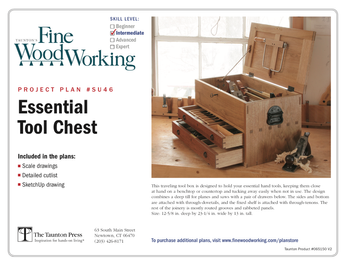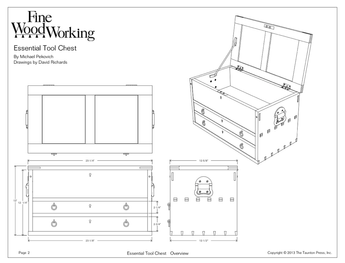Here are a few strategies for producing tight dovetails. http://www.inthewoodshop.com/Furniture/MakingBetter%20Dovetails.html Let’s have a few more additions of your own. Regards from Perth Derek
Discussion Forum
Get It All!
UNLIMITED Membership is like taking a master class in woodworking for less than $10 a month.
Start Your Free TrialCategories
Discussion Forum
Digital Plans Library
Member exclusive! – Plans for everyone – from beginners to experts – right at your fingertips.
Highlights
-
Shape Your Skills
when you sign up for our emails
This site is protected by reCAPTCHA and the Google Privacy Policy and Terms of Service apply. -
 Shop Talk Live Podcast
Shop Talk Live Podcast -
 Our favorite articles and videos
Our favorite articles and videos -
E-Learning Courses from Fine Woodworking
-
-
 Fine Woodworking New England Event
Fine Woodworking New England Event -












Replies
Derek,
After transferring the tail cuts to the pins, do you draw a square line down the face of the pin board to follow? And how much time would you estimate it takes you to cut and fit the dovetails on a box like the drawer you show (not rushing, but taking your time to get it right)?
I've been on a hand-cut dovetail kick recently (again). I bought myself a nice new saw that looks a lot like yours.
I've never thought about bevelling the insides of the tails. If the joint is too tight, isn't there a greater danger of splitting the pin board because of the bevels? I realize that the clamp you added pretty much prevents this though...
I've never thought to sight along the back of the chisel and the "vertical" scribe line. I would add that it is important to sneak up on the scribe line so that the last cut removes only 1/32" or so - otherwise, the chisel can be deflected beyond the scribe line. Also, the chisel should be able to register in the scribe line very positively.
One benefit of using a Western saw over a Japanese saw is that the fret saw blade will slide down the kerf of the Western saw and from there, you just turn the saw to cut out the waste. Some Japanese saws leave a kerf so thin that the fret saw will actually widen the kerf, so it may be better to cut down to the baseline with the fret saw, then across.
I've never thought about
I've never thought about bevelling the insides of the tails. If the joint is too tight, isn't there a greater danger of splitting the pin board because of the bevels? I realize that the clamp you added pretty much prevents this though...
Hi Chris
The bevel simply prevents bruising the nice, straight edges you have worked so hard to create. With two hardwoods, neither of which will compress much, one has to be careful how "fat" the pin/tail is. With one soft, squishy wood used, you can compress quite easily (this is what you see in the videos!). The bevel helps with both.
One benefit of using a Western saw over a Japanese saw is that the fret saw blade will slide down the kerf of the Western saw and from there, you just turn the saw to cut out the waste. Some Japanese saws leave a kerf so thin that the fret saw will actually widen the kerf, so it may be better to cut down to the baseline with the fret saw, then across.
While my first preference is a fretsaw/jeweller's saw (I just find the extra, smaller teeth provide more control over a coping saw, so I can saw closer to the baseline), I may either chop out the waste (if the wood is soft) or use a coping saw (sometimes the blades in the fretsaw have snapped and I do not have a replacement).
When using a coping saw, I do not try and slot it down the kerf (although the ones I have from Joel at TFWW will do this). Instead I make a diagonal cut, then a second one to remove the remaining waste. The advantage of a coping saw is that you can torn the blade.
View Image
Regards from Perth
Derek
Derek,
My fret saw has a 12" throat, so I can work to the center of a nearly 2' wide board. However, even though the frame is light, it is still fatiguing to use given the less-than ideal balance when used horizontal (when scrolling with the fret saw, I'm not balancing the arm nearly as much). I suppose I should look into a fret saw with a shorter arm.
I use 14TPI skip tooth blades and don't worry too much about cutting too close to the line. Maybe as I get more practiced with it, I will dare to cut just off the line. Right now, my primary concern is to get out most of the waste (~75%) so that it doesn't wedge itself when I chop.
After deciding on the ratio, size, and layout, and marking them with a (left or right) knife, I uncover the dozuki and my Japanese chisels. They are so sharp, the waste material runs off on its own out of fear. ;-)
Ooh! Good tip! Send that one to Fine Woodworking, why don't you.
Thanks for the dovetail lesson. I mostly use my Leigh but I do 'try' to handcut sometimes. I do just OK. Not bad but it takes me so much time to do them.
I loved your suggestion "... use a chisel to chamfer a fence for your saw.". I did that this morning as a test on some scrap and it really helped getting that saw started in a straight line!
"... I prefer to remove waste with a fretsaw/jeweller's saw than chop it out".
I used a inexpensive jewellers saw.. Big mistake! I bought a much more expensive one that had a stiff frame and all my 'fretting' sorrows went away. The frame of the inexpensive saw would flex and then disaster....
"... If you need to chop out waste in hardwood, a guide fence can aid in maintaining even baselines."
Most if not all of my work is hardwoods. I ALWAYS use a wooden block to guide my chisel! My glasses make things look like a curve depending on the distance to the object.
"... I made a “Rest Block”.
I clamp the two boards at the edges.
"... Prior to joining the boards pare a chamfer on the backs of the tails before wacking them into the pins."
I will try that and I hope that I always remember to do it on the correct face!
Those tiny drawer front dovetails really look nice but do they really have any holding strength?
Have a great day!
Very skillful, thanks for sharing. I looked at your thicknessing technique also, it's certainly a different approach than I would take. Using the hand work techniques you describe makes the art of woodworking as much in the process as in the final product. Although I consider myself skilled, I'm more of a production wonk. In my work, I do try to design in some elements that demonstrate hand work and skill but it would be the rare client that would appreciate the time involved in thicknessing panels with hand planes.
.
Question: On a hand thicknessed panel like you've shown, would you sand it, or leave unsanded so the admirers can fully appreciate (and feel) the effort involved?
From an opposite approach, I've taken hand planes to machined table tops to create a more hand tooled look. I had to explain to the client why I left unsanded the very subtle edges left by my hand planes. I think the average consumer would more appreciate some nice dovetails or some other form of exposed joinery.
.
I should go sharpen my plane irons but there is some football to watch this afternoon.
I once lapped the bottom of a plane sole on the coffee table while watching something on TV. The process was quite enjoyable and went quickly.
I tried knifing in the cut lines on the pin board, and couldn't find the knife kerf. I went back to .5mm mechanical pencil. How do you highlight the knife kerf?
When sawing through cuts, I had more luck making my initial saw passes full length rather than short back and forth chopping motion. Gave my arm a chance to learn the motion.
I aim for a strong scoring line marking the depth of the tails and pins. With a shallow score, chopping the last 32nd, a slight chip sometimes ran beyond the score.
Some very minor points.
This forum post is now archived. Commenting has been disabled